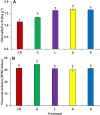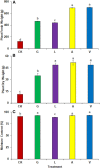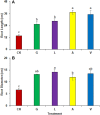Biostimulants induce positive changes in the radish morpho-physiology and yield
- PMID: 36003805
- PMCID: PMC9393613
- DOI: 10.3389/fpls.2022.950393
Biostimulants induce positive changes in the radish morpho-physiology and yield
Abstract
An ever-increasing population has issued an open challenge to the agricultural sector to provide enough food in a sustainable manner. The upsurge in chemical fertilizers to enhance food production had resulted in environmental problems. The objective of the current study is to assess the utilization of biostimulants for sustainable agricultural production as an alternative to chemical fertilization. For this purpose, two pot experiments were conducted to examine the response of radish against individual and combined applications of biostimulants. In the first experiment, the effects of chemical fertilizer (CK), glycine (G), lysine (L), aspartic acid (A), and vitamin B complex (V) were studied. The results demonstrated that V significantly improved the transpiration rate (81.79%), stomatal conductance (179.17%), fresh weight (478.31%), and moisture content (2.50%). In the second experiment, tested treatments included chemical fertilizer (CK), Isabion® (I), glycine + lysine + aspartic acid (GLA), moringa leaf extract + GLA (M1), 25% NPK + M1 (M2). The doses of biostimulants were 5g L-1 glycine, 1g L-1 lysine, 2g L-1 aspartic acid, and 10 ml L-1 moringa leaf extract. The photosynthetic rate improved significantly with GLA (327.01%), M1 (219.60%), and M2 (22.16%), while the transpiration rate was enhanced with GLA (53.14%) and M2 (17.86%) compared to the Ck. In addition, M1 increased the stomatal conductance (54.84%), internal CO2 concentration (0.83%), plant fresh weight (201.81%), and dry weight (101.46%) as compared to CK. This study concludes that biostimulants can effectively contribute to the sustainable cultivation of radish with better growth and yield.
Keywords: biostimulants; fertilization; glycine; radish; vegetable production.
Copyright © 2022 Raza, Bashir, Rehim, Ejaz, Raza, Shahzad, Ahmed and Geng.
Conflict of interest statement
Author YG was employed by KOYO Star Agriculture Technology Co., LTD. The remaining authors declare that the research was conducted in the absence of any commercial or financial relationships that could be construed as a potential conflict of interest.
Figures









References
-
- Abd El-Mageed T. A., Semida W. M., Rady M. M. (2017). Moringa leaf extract as biostimulant improves water use efficiency, physio-biochemical attributes of squash plants under deficit irrigation. Agric. Water Manag. 193, 46–54. 10.1016/j.agwat.2017.08.004 - DOI
-
- Ahmad S., Cui W., Kamran M., Ahmad I., Meng X., Wu X., et al. . (2021). Exogenous application of melatonin induces tolerance to salt stress by improving the photosynthetic efficiency and antioxidant defense system of maize seedling. J. Plant Growth Regul. 40, 1270–1283. 10.1007/s00344-020-10187-0 - DOI
-
- Alfosea-Simón M., Simón-Grao S., Zavala-Gonzalez E. A., Cámara-Zapata J. M., Simón I., Martínez-Nicolás J. J., et al. . (2020). Application of biostimulants containing amino acids to tomatoes could favor sustainable cultivation: implications for tyrosine, lysine, and methionine. Sustainability 12, 1–19. 10.3390/su12229729 - DOI - PubMed
-
- Alfosea-Simón M., Simón-Grao S., Zavala-Gonzalez E. A., Cámara-Zapata J. M., Simón I., Martínez-Nicolás J. J., et al. . (2021). Physiological, nutritional and metabolomic responses of tomato plants after the foliar application of amino acids aspartic acid, glutamic acid and alanine. Front. Plant Sci. 11, 581234. 10.3389/fpls.2020.581234 - DOI - PMC - PubMed
-
- Ali Q., Perveen R., El-Esawi M. A., Ali S., Hussain S. M., Amber M., et al. . (2020). Low doses of cuscuta reflexa extract act as natural biostimulants to improve the germination vigor, growth, and grain yield of wheat grown under water stress: Photosynthetic pigments, antioxidative defense mechanisms, and nutrient acquisition. Biomolecules 10, 1–30. 10.3390/biom10091212 - DOI - PMC - PubMed
LinkOut - more resources
Full Text Sources
Research Materials

